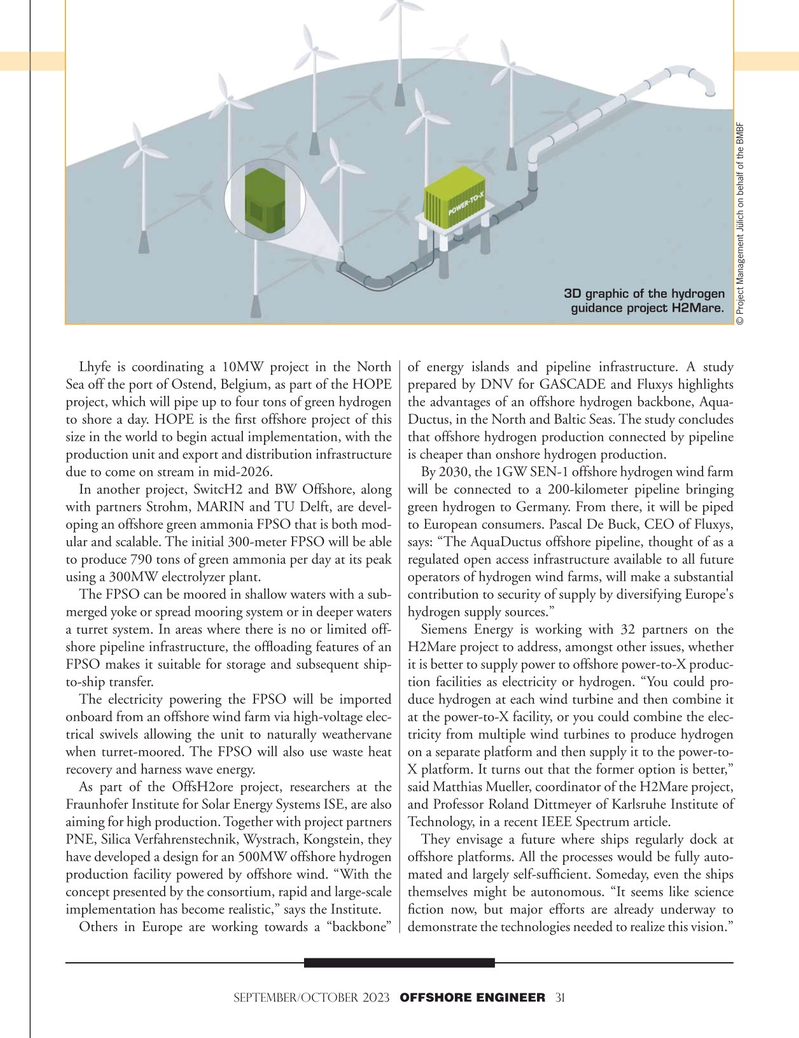
Page 30: of Offshore Engineer Magazine (Sep/Oct 2023)
Read this page in Pdf, Flash or Html5 edition of Sep/Oct 2023 Offshore Engineer Magazine
3D graphic of the hydrogen guidance project H2Mare.
© Project Management Jülich on behalf of the BMBF
Lhyfe is coordinating a 10MW project in the North of energy islands and pipeline infrastructure. A study
Sea off the port of Ostend, Belgium, as part of the HOPE prepared by DNV for GASCADE and Fluxys highlights project, which will pipe up to four tons of green hydrogen the advantages of an offshore hydrogen backbone, Aqua- to shore a day. HOPE is the ?rst offshore project of this Ductus, in the North and Baltic Seas. The study concludes size in the world to begin actual implementation, with the that offshore hydrogen production connected by pipeline production unit and export and distribution infrastructure is cheaper than onshore hydrogen production. due to come on stream in mid-2026. By 2030, the 1GW SEN-1 offshore hydrogen wind farm
In another project, SwitcH2 and BW Offshore, along will be connected to a 200-kilometer pipeline bringing with partners Strohm, MARIN and TU Delft, are devel- green hydrogen to Germany. From there, it will be piped oping an offshore green ammonia FPSO that is both mod- to European consumers. Pascal De Buck, CEO of Fluxys, ular and scalable. The initial 300-meter FPSO will be able says: “The AquaDuctus offshore pipeline, thought of as a to produce 790 tons of green ammonia per day at its peak regulated open access infrastructure available to all future using a 300MW electrolyzer plant. operators of hydrogen wind farms, will make a substantial
The FPSO can be moored in shallow waters with a sub- contribution to security of supply by diversifying Europe's merged yoke or spread mooring system or in deeper waters hydrogen supply sources.” a turret system. In areas where there is no or limited off- Siemens Energy is working with 32 partners on the shore pipeline infrastructure, the of?oading features of an H2Mare project to address, amongst other issues, whether
FPSO makes it suitable for storage and subsequent ship- it is better to supply power to offshore power-to-X produc- to-ship transfer. tion facilities as electricity or hydrogen. “You could pro-
The electricity powering the FPSO will be imported duce hydrogen at each wind turbine and then combine it onboard from an offshore wind farm via high-voltage elec- at the power-to-X facility, or you could combine the elec- trical swivels allowing the unit to naturally weathervane tricity from multiple wind turbines to produce hydrogen when turret-moored. The FPSO will also use waste heat on a separate platform and then supply it to the power-to- recovery and harness wave energy. X platform. It turns out that the former option is better,”
As part of the OffsH2ore project, researchers at the said Matthias Mueller, coordinator of the H2Mare project,
Fraunhofer Institute for Solar Energy Systems ISE, are also and Professor Roland Dittmeyer of Karlsruhe Institute of aiming for high production. Together with project partners Technology, in a recent IEEE Spectrum article.
PNE, Silica Verfahrenstechnik, Wystrach, Kongstein, they They envisage a future where ships regularly dock at have developed a design for an 500MW offshore hydrogen offshore platforms. All the processes would be fully auto- production facility powered by offshore wind. “With the mated and largely self-suf?cient. Someday, even the ships concept presented by the consortium, rapid and large-scale themselves might be autonomous. “It seems like science implementation has become realistic,” says the Institute. ?ction now, but major efforts are already underway to
Others in Europe are working towards a “backbone” demonstrate the technologies needed to realize this vision.” september/october 2023 OFFSHORE ENGINEER 31

 29
29

 31
31